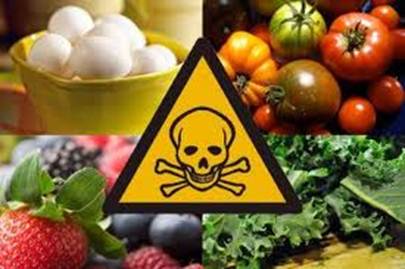
Here’s what you need to know to keep you and
your loved ones from food-borne diseases.
Collette
Skelley was desperately trying to listen to her friend Mary as she chatted
away. The women had both ordered the marlin at a popular Toronto restaurant and
were just a few bites in when Skelley began to feel dizzy and uncomfortable.
“The pattern on the back of the couch where Mary was sitting began to blur and
move,” she says. “And I began to feel a bit warm.” After walking around the
restaurant and stepping outside for some air, Skelley only felt worse. “I think
I’m going to have to leave,” she told her friend.
She
barely made it home before the vomiting and diarrhea began. “I’ve never been so
sick in my life,” she recalls now. Even more worrisome, the whites of her eyes
were ”the colour of a red apple.” Skelley’s grown son took one look and called
the poise control hotline. The verdict: scombroid, a food-borne illness caused
by bad fish. While Skelley had a terrible night, she considers herself lucky.
“I was better by the next morning,” she says, “but Mary ended up in hospital.”
While
she
may have had a particularly bad case of food poisoning, Skelley’s case
is
far from unique. The Canadian Food Inspection Agency (CFIA) estimates
there are
some 11 to 13 million cases of food-borne illness every year in Canada.
That means about one in every three Canadians will suffer from food
poisoning
annually. The good news: whether you’re eating at home or dining out,
there are
ways to reduce your risk.
Dining Out

As
Shelley and her friend found out, dining out comes with a side serving of risk.
While no one knows for sure how many cases of food poisoning are caused by
restaurant foods, one analysis by the Centers for Disease Control and
Prevention in the United State indicated that about 52 per cent of food-borne
illnesses between 1998 and 2004 were associated with restaurants, delis,
cafeterias, or hotels.
Jim
Chan,
who has been a health inspector for the City of Toronto for 34 years,
still manages to enjoy eating out. “I do have confidence in general in
food
operators,” he says, pointing out that only 36 of the 16,000 restaurants
in Toronto were closed down last year for health violations.
Nonetheless, he points out,
there’s nothing wrong with applying a dad of caution when you’re eating
outside
the home.
Check
out the restaurant’s record. Since
the City of Toronto introduced its Dine Safe program in 2001,the number of
crucial (potentially dangerous) infractions identified by health inspectors and
the reported incidents of food-borne illnesses have both dropped. The key
reason: restaurants must post the results of inspections in the form of either
a green sign (pass), a yellow sign (indicates a significant infraction that
mist be dealt with in 48 hours), or a red sign (the restaurant is shut down
over food safety concerns). Several other municipalities have introduced
similar programs. But even if yours isn’t one of them, you can generally check
out a restaurant’s food safety record online. Try www.healthinspections.ca to locate restaurant inspection
reports for your area.
Listen
to your eyes. “Don’t
be wooed by nice decorations,” Chan advises. Look in the corners of the dining
room for dirt and check out the food serving station, the fingernails of your
server, and the cutlery on the table. In addition, he says, take note of
conditions in the washrooms. “If the soap containers aren’t being filled and
there’s paper, dirt, and garbage all over the place, that’s and indication that
operator is not paying attention to rest of the establishment.” Run away. Fast.
Make
sure it’s done like dinner. Meat,
fish, and poultry need to be well cooked. If you notice reddish-hued juice
running out of your dinner, or a glutinous texture in the case of fish, send it
back to be cooked some more, or choose another menu option, Chan says. “From a
health inspector’s point of view, that is undercooked and that increases your
chance of getting food poisoning.”
Opt
for ever-easy. Or
scrambled.
Or boiled. Or omelettes. Although eggs are generally very safe in
Canada, Chan says, “we still advise that people avoid eating very
running, undercooked
eggs.”
Feeling
hot, hot, hot. If
your soup is served cold, or the hot food on a buffet isn’t steamy, it might
indicate that food has been sitting around too long. “We always tell operators
not to put out a big tray of chicken and let it sit for an hour or two,” Chan
says. “Instead they should put out a smaller portion and keep refilling it.”
Chill
out. Just as hot food
should be kept hot, cold food needs to be chilled. Look for salad greens and
other cold food items to be sitting on a bed of ice at a buffet.
Treat
doggy bags with caution. If
you’ve had a lingering dinner you might want to think twice about taking your
half-eaten steak, or even your rice or pasta, home in a doggie bag. “It may
have been sitting there for several hours already,” Chan warns. “And then you
might add another hour or two of incubation time for the bacteria before you
get it in the refrigerator.” When you reheat leftovers, he advises, make sure
the food gets really hot “as close to the cooking temperature as possible.”
(See chart for suggested cooking temps.)
Tattle.
If you think there’s
a food safety risk out there, call your local health unit and inform the safety
inspector. “We respond to 2,000 to 3,000 complaints per year,” Chan says, “We
investigate them all.”